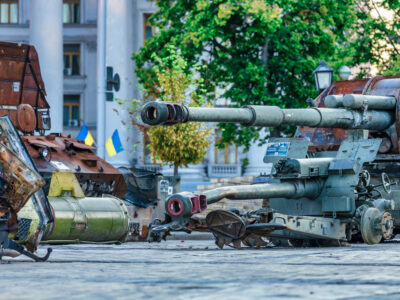The crash of a Polish airplane in the Russian territory of Smolensk last weekend is a stunning tragedy, taking the life of Polish President Lech Kaczynski, his wife, and high-level figures in the Polish government. Upwards of 100 people were obliterated. Kaczynski was a former Solidarity freedom fighter, and wonderfully anti-Soviet, anti-Russian, and pro-American.
The event, obviously, is international front-page news. What was not, however, was the event that inspired Kaczynski’s flight: the 1940 Katyn Woods massacre. This, too, was a stunning tragedy, one not admitted by the Russians for nearly 50 years, when Soviet leader Mikhail Gorbachev finally, officially conceded the USSR’s responsibility.
Here, it’s worth pausing to revisit what happened at Katyn. Doing so is a fitting tribute to Poland’s horrible loss.
The Katyn Woods massacre was one of the worst war crimes of the bloody 20th century. It was rooted in a pact between two devils, Hitler and Stalin, who in September 1939 jointly invaded, annihilated, and partitioned Poland. The Soviets seized thousands of Polish military officers as prisoners. Their fate was secretly sealed on March 5, 1940 when Stalin signed their death warrant, condemning 21,857 of them to “the supreme penalty: shooting.”
What happened next remained a state secret for a half-century. The Polish officers were taken to three primary sites, the most infamous of which bears the namesake of the crime: the Katyn Woods, located 12 miles west of Smolensk, Russia. There, these unsuspecting men, Poland’s best and brightest, were methodically slaughtered like farm animals. The Bolsheviks covered their crime with a thin layer of dirt.
The locals shuddered at the howling cries of dying men echoing through their once peaceful woods. One Russian farmer later told authorities: “For approximately four to five weeks there were three to four trucks daily driving to the forest loaded with people…. I could hear the shooting and screaming of men’s voices.”
Some Poles were destroyed on site in the forest, whereas others were first shot in the NKVD prison in Smolensk, with their rotting corpses transported to Katyn for burial under a few inches of soil.
At the prison, bullets were fired 24/7 by a cadre of deranged, homicidal NKVD/KGB killers who were so consumed with bloodlust, and so taken by the dark side that, in the end, their work finished, they turned their guns on themselves. Death had consumed them.
In April 1943, it was the Germans, then at war with the USSR and advancing with lightning speed into Soviet territory, who discovered the mass graves. They immediately tried to turn the atrocity into a propaganda coup to split the Big Three Allies: the USSR, the United Kingdom, and the United States. Of course, the Soviets, being masters of lies, responded by claiming the Nazis were the perpetrators. Stalin and his goons attempted to blame Hitler and his goons. Stuck in between was the rest of the civilized world, which sought to determine which devil did the deed.
For the record, in the United States, Ambassador Jan Ciechanowski of the Polish government-in-exile and Congressman John Lesinski (D-Mich.) were certain the Soviets did it. For this, they were denounced by FDR’s hideous Office of War Information, which we now know was one of the most infiltrated agencies of the entire wartime federal government, penetrated by communist spies and sympathizers. FDR refused to believe that the government of his pal “Uncle Joe”—his term of endearment for Stalin—was involved. This greatly frustrated men like former Pennsylvania Governor George Earle, a fellow Democrat who FDR had appointed to investigate the matter, and who knew the Soviets were guilty as sin.
FDR disagreed, fully buying the Soviet line, telling Earle: “George, they [the Nazis] could have rigged things up. The Germans could have rigged things up.”
The liberal/progressive icon insisted to his special emissary: “I’m absolutely convinced that the Russians didn’t do this.” An amazed Earle responded: “Mr. President, I think this evidence is overwhelming.” Of course, it was. (For an outstanding book and companion video series that includes this extraordinary exchange, see Laurence Rees’ WWII Behind Closed Doors.)
What happened at Katyn 70 years ago this spring was one of the most terrible human-rights atrocities of the 20th century, which is saying something. It deserves the same infamy as words like “Rape of Nanking” or “Buchenwald” or “Auschwitz.” The people of Poland have never forgotten. Chief among them was Poland’s proud president, who was on his way to pay remembrance when he, too, breathed his last in a violent death in the Russian territory of Smolensk.
Let’s pay tribute to his and Poland’s loss by remembering Katyn, and teaching the world about this forgotten tragedy of history.




